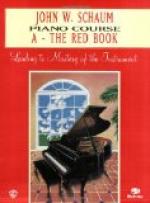Paderewski is known as composer and pianist, only rarely does he find time to give instruction on his instrument. Mme. Antoinette Szumowska, the Polish pianist and lecturer was at one time termed his “only pupil.” Mr. Sigismond Stojowski, the Polish composer, pianist and teacher has also studied with him. Both can testify as to his value as an instructor.
Mme. Szumowska says:
“Paderewski lays great stress on legato playing, and desires everything to be studied slowly, with deep touch and with full, clear tone. For developing strength he uses an exercise for which the hand is pressed against the keyboard while the wrist remains very low and motionless and each finger presses on a key, bringing, or drawing out as much tone as possible.
“Paderewski advises studying scales and arpeggios with accents, for instance, accenting every third note, thus enabling each finger in turn to make the accent impulse: this will secure evenness of touch. Double passages, such as double thirds and sixths, should be divided and each half practised separately, with legato touch. Octaves should be practised with loose wrists and staccato touch. As a preparatory study practise with thumb alone. The thumb must always be kept curved, with joints well rounded out; it should touch the keys with its tip, so as to keep it on a level with the other fingers. Paderewski is very particular about this point.
“It is difficult to speak of Paderewski’s manner of teaching expression, for here the ideas differ with each composer and with every composition. As to tonal color, he requires all possible variety in tone production. He likes strong contrasts, which are brought out, not only by variety of touch but by skilful use of the pedals.
“My lessons with Paderewski were somewhat irregular. We worked together whenever he came to Paris. Sometimes I did not see him for several months, and then he would be in Paris for a number of weeks; at such seasons we worked together very often. Frequently these lessons, which were given in my cousin’s house, began very late in the evening—around ten o’clock—and lasted till midnight, or even till one in the morning.
“Paderewski the teacher is as remarkable as Paderewski the pianist. He is very painstaking; his remarks are clear and incisive: he often illustrates by playing the passage in question, or the whole composition. He takes infinite trouble to work out each detail and bring it to perfection. He is very patient and sweet tempered, though he can occasionally be a little sarcastic. He often grows very enthusiastic over his teaching, and quite forgets the lapse of time. In general, however, he does not care to teach, and naturally has little time for it.”
* * * * *
Mr. Stojowski, when questioned in regard to his work with the Polish pianist, said:




